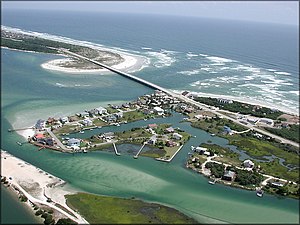
The Massacre at Matanzas Inlet was the mass killing of French Huguenots by Spanish Royal Army troops near the Matanzas Inlet in 1565, under orders from King Philip II to Pedro Menéndez de Avilés, the adelantado of Spanish Florida (La Florida).
The Spanish Crown in the 16th century laid claim to a vast area that included what is now the state of Florida, along with much of what is now the southeastern United States, on the strength of several Spanish expeditions made in the first half of the 1500s, including those of Ponce de Leon and Hernando de Soto. However, Spanish attempts to establish a lasting presence in La Florida failed until September 1565, when Menéndez founded St. Augustine about 30 miles south of the newly established French settlement at Fort Caroline on the St. Johns River. Menéndez had not known that the French had already arrived in the area, and upon discovering the existence of Fort Caroline, he aggressively moved to expel those whom he considered heretics, pirates, and invaders. He marched with troops overland and attacked the Huguenot settlement, sparing only women, children, Catholic males, and a few skilled craftsmen.
When the French Huguenot leader, Jean Ribault, learned of the Spanish presence nearby, he also decided on a swift assault and sailed south from Fort Caroline with most of his troops to search for the Spanish settlement. His ships were struck by a storm (probably a tropical storm) and most of the French force was lost at sea, leaving Ribault and several hundred survivors in two groups shipwrecked with limited food and supplies: one group about 15 miles south of the Spanish colony, and Ribault's group much farther southward at Cape Canaveral. Meanwhile, Menéndez marched north, overwhelmed the remaining defenders of Fort Caroline, massacred most of the French Protestants in the town, and left an occupying force in the rechristened fort, now called "San Mateo" by the Spanish. Upon returning to St. Augustine, he received news that Ribault and his troops were stranded to the south. Menéndez quickly moved to attack and massacred the French force of two separate parties on the shore of what became known as the Matanzas River.
- ^ William Whitwell Dewhurst (1881). The History of Saint Augustine, Florida: With an Introductory Account of the Early Spanish and French Attempts at Exploration and Settlement in the Territory of Florida. G. P. Putnam's sons. p. 95.
© MMXXIII Rich X Search. We shall prevail. All rights reserved. Rich X Search
